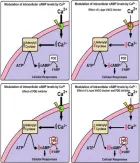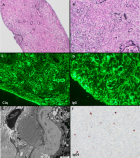Early Online (Volume - 8 | Issue - 2)
Necrotizing Fasciitis in Neonates Case Series
Published on: 1st September, 2025
Introduction: Necrotizing Fasciitis (NF) is a rapidly progressing and life-threatening soft tissue infection, exceedingly rare but often fatal in neonates. This case series highlights the rarity, fulminant nature, and poor prognosis of neonatal NF by presenting four cases.Case presentation: Four neonates, aged 12-16 days, presented with rapidly spreading, tender, erythematous, and indurated skin lesions on their backs, initially resembling burns. Systemic symptoms like fever, lethargy, and poor feeding were common. Despite empirical antibiotics, the lesions progressed to necrosis, often with bullae formation. Microbiological cultures revealed polymicrobial growth in three cases (E. coli, Pseudomonas sp., Klebsiella, and MRSA) and monomicrobial growth of MRSA in one case, frequently exhibiting antibiotic resistance. Surgical debridement was performed in three cases. Despite aggressive management, two neonates succumbed to sepsis and multi-organ dysfunction. The other two neonates recovered after prolonged antibiotic therapy and wound care.Discussion: These cases underscore the diagnostic challenges and rapid progression of NF in neonates. The consistent presentation after 10 days of birth, rapid lesion spread mimicking burns, and predilection for the back were notable features. Polymicrobial infection was frequent. Early recognition, aggressive broad-spectrum antibiotics, and timely surgical debridement are crucial for improving the poor prognosis associated with this condition.
The Role of Anemia of Inflammation in the Course of Chronic HBV Infection in Children
Published on: 2nd September, 2025
The article evaluates the features of the course of chronic HBV infection in children with the background of anemia of inflammation. A brief description of the clinical and laboratory manifestations of the disease is given, depending on the course of anemia and inflammation. The data on hepcidin dynamics are analyzed. The stage–by-stage formation of iron metabolism disorders was revealed, in the form of a true deficiency with a breakdown of ferrokinetic markers – an increase in hepcidin and soluble transferin receptors with the background reduced ferritin values characteristic of iron deficiency anemia in the initial stages of the disease and, redistributive iron deficiency - decrease in hepcidin and soluble transferrin receptors with the background increased ferritin values characteristic of iron overload the body is in the late stages of the disease.
Excipients and Vehicles in Galenic Practice: Considerations for Neonatology and Pediatrics: An Overview and Results of a Practical Experience
Published on: 2nd October, 2025
Excipients are fundamental components of galenic formulations, critically influencing the safety and efficacy of the final medicinal product. This is of paramount importance in neonatal and pediatric populations, where physiological immaturity results in significant differences in pharmacokinetics and pharmacodynamics compared to adults. This work provides a comprehensive overview of excipients and vehicles used in galenic preparations for these vulnerable groups. It highlights specific excipients known to be dangerous, detailing their mechanisms of toxicity, and suggests safer alternatives. The discussion covers formulations for oral solutions, suspensions, and topical dermatological use, including ready-to-use vehicles. The role of the prescribing physician and the verifying pharmacist is emphasized, underscoring the necessity of checking for efficacy, safety, incompatibilities, and microbiological compatibility. The results of a practical five-year local experience with an observational analysis are provided.Furthermore, innovative technologies such as 3D printing for pediatric dosage forms are discussed. The conclusion asserts that a rigorous, risk-based assessment of excipients is essential in neonatal and pediatric galenic practice to ensure patient safety.
Employee Performance Assessment Methods: A Scoping Review
Published on: 16th October, 2025
Background: Employee performance appraisal is essential for improving healthcare service delivery through systematic staff evaluation. In the health sector, effective appraisals support decision-making and professional development.Objective: This study aims to map and categorize existing employee performance appraisal methods in the health system using a scoping review approach.Methods: This scoping review was conducted using the JBI 2024 protocol. Articles published up to December 2024 were identified through four databases: PubMed, Scopus, Web of Science, and Google Scholar. The keywords used were “Personnel appraisal,” “Health workers,” and “Health workforce.” The inclusion criteria focused on studies assessing employee appraisal methods in health systems.Results: Of the 1,245 articles initially identified, 18 met the inclusion criteria. Appraisal methods were classified into traditional and modern categories. Traditional methods included ranking, critical incidents, and graphic rating scales. Modern approaches involved 360-degree feedback, Management by Objectives (MBO), and Behaviorally Anchored Rating Scales (BARS).Conclusion: No single appraisal method suits all healthcare environments. A hybrid approach tailored to organizational context and job roles is recommended. Emphasis should be placed on objective evaluation, customization, and the degree of scientific connection between the evaluator and the evaluated person to improve performance outcomes.

If you are already a member of our network and need to keep track of any developments regarding a question you have already submitted, click "take me to my Query."


















































































































































